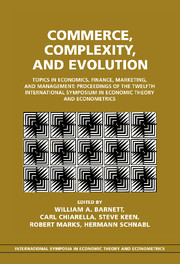 Commerce, Complexity, and Evolution
Commerce, Complexity, and Evolution Book contents
- Frontmatter
- Contents
- Series editor's preface
- Volume editors' preface
- Editors
- List of contributors
- I Philosophical and methodological implications of complexity and evolution in economic systems
- II Finance and the macroeconomy
- III Market and sectoral dynamics
- 10 Evolutionary patterns of multisectoral growth dynamics
- 11 The detection of evolutionary change in nonlinear economic processes: a new statistical methodology
- 12 Ergodic chaos in a piecewise linear cobweb model
- 13 The cobweb model and a modified genetic algorithm
- 14 The convergence of genetic learning algorithms, with particular reference to recent cobweb models
- IV Marketing and interdependent behavior
10 - Evolutionary patterns of multisectoral growth dynamics
Published online by Cambridge University Press: 05 December 2011
- Frontmatter
- Contents
- Series editor's preface
- Volume editors' preface
- Editors
- List of contributors
- I Philosophical and methodological implications of complexity and evolution in economic systems
- II Finance and the macroeconomy
- III Market and sectoral dynamics
- 10 Evolutionary patterns of multisectoral growth dynamics
- 11 The detection of evolutionary change in nonlinear economic processes: a new statistical methodology
- 12 Ergodic chaos in a piecewise linear cobweb model
- 13 The cobweb model and a modified genetic algorithm
- 14 The convergence of genetic learning algorithms, with particular reference to recent cobweb models
- IV Marketing and interdependent behavior
Summary
Most studies of economic growth concentrate on aggregate data. However, careful examination of intersectoral growth patterns shows a large divergence among sectors. These are driven as much by intersectoral linkages as they are by the separate characteristics of each sector. Arguing, for example, that a certain sector, e.g., machine tools, has a higher growth potential than, e.g., agriculture certainly is right but does not sufficiently take into account that all sectors are interlaced to each other, but rather to a highly diverging extent that then accounts for a diverging dynamic.
We investigate those interdependencies of sectoral dynamics on an empirical basis by using a time series of German input–output (10) tables (58 sectors) of more than a decade (1978 to 1990) and derive the growth pattern of the economy in terms of its sectoral growth. Techniques designed to illuminate the impact of one sector's development on others are applied. Thus we proceed in establishing the analytical tools for this purpose in Sections 1 and 2, showing and analyzing the empirical, i.e., factual, observations in Section 3 and deriving a theoretical hypothesis compatible with those findings in Section 4.
The opportunity to analyze those qualitative differences in sectoral interdependencies – with the option also to recognize dynamic differentials – was opened up by the so-called qualitative input–output analysis (QIOA), which was developed by Czayka (1972), Schnabl and Holub (1979), Holub et al. (1985), as well as Holub and Tappeiner, following those just mentioned. In France, some other applications of graph-theoretical methods for structuring production have been brought forward (see Bellet et al. 1989, Torre 1993).
Information
- Type
- Chapter
- Information
- Commerce, Complexity, and EvolutionTopics in Economics, Finance, Marketing, and Management: Proceedings of the Twelfth International Symposium in Economic Theory and Econometrics, pp. 215 - 232Publisher: Cambridge University PressPrint publication year: 2000
Accessibility standard: Unknown
Why this information is here
This section outlines the accessibility features of this content - including support for screen readers, full keyboard navigation and high-contrast display options. This may not be relevant for you.Accessibility Information
- 1
- Cited by